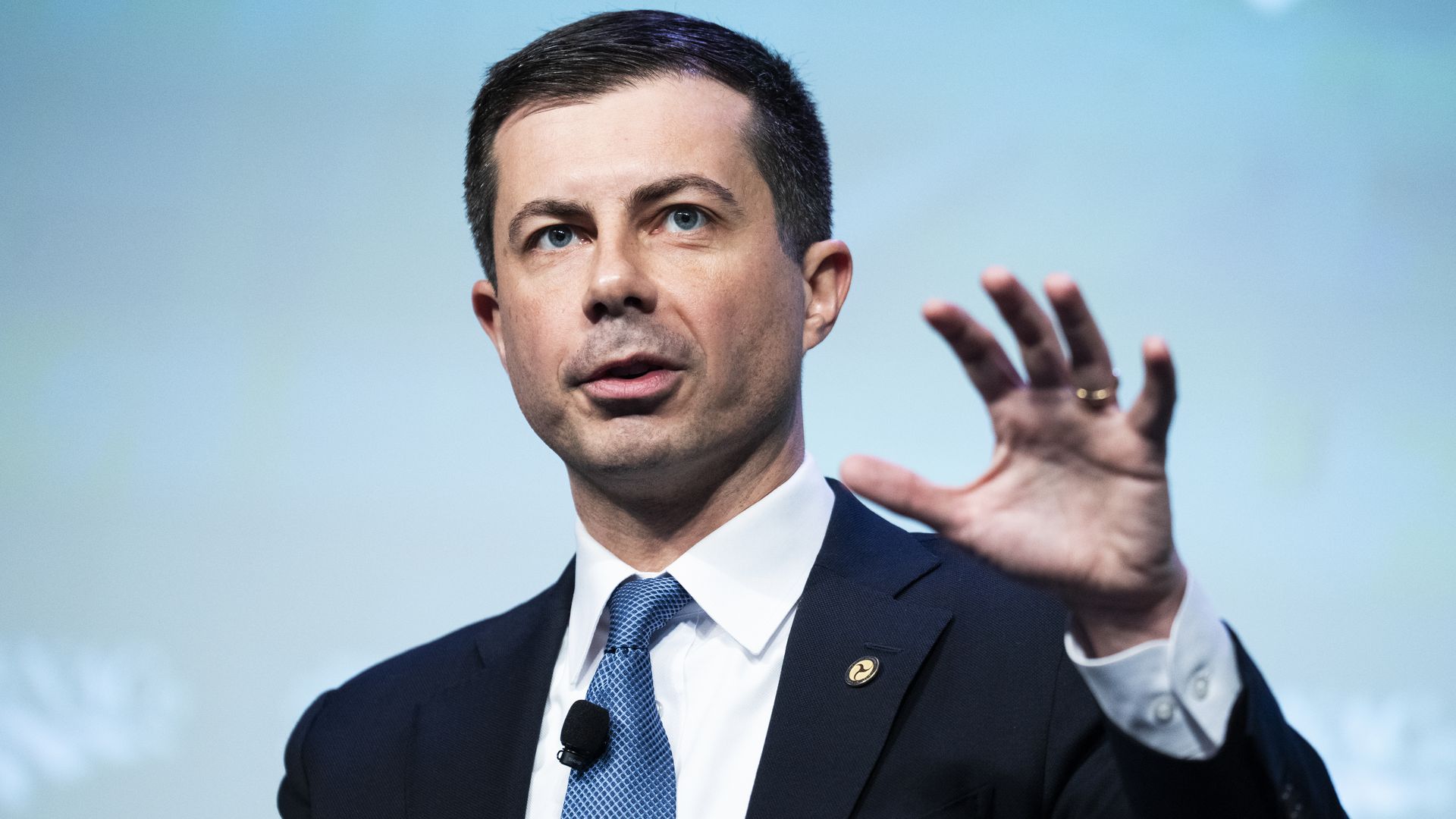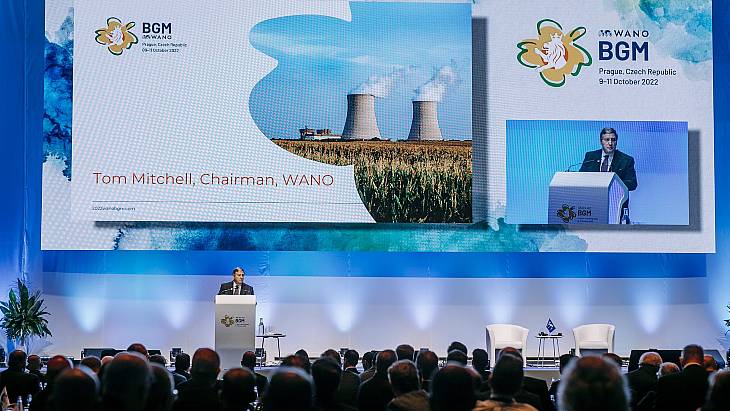Buttigieg urges Norfolk Southern to support Ohio town after train derailment
- Jacob Knutson 20/02/2023

Transportation Secretary Pete Buttigieg speaking in Washington, D.C., on Feb. 13.
Photo: Tom Williams/CQ-Roll Call, Inc via Getty Images
Transportation Secretary Pete Buttigieg sent rail operator Norfolk Southern a letter on Sunday over the derailment of one of its trains carrying hazardous materials near East Palestine, Ohio, earlier this month.
Why it matters: In the three-page letter to Norfolk Southern president and CEO Alan Shaw, Buttigieg accused the company of putting profits before safety measures and urged it to "demonstrate unequivocal support for the people" of East Palestine.
- Train cars carrying at least five different types of chemicals were involved in the derailment, and at least three of those chemicals were either spilled during or released and burned after the wreck.
- After the derailment, the company released and burned vinyl chloride, a colorless but hazardous and carcinogenic gas used to produce PVC plastic and vinyl products, from five tanker cars because of an explosion risk.
- At least one now-dammed local waterway was contaminated as a result of the crash.
What they're saying: "The arithmetic suggests Norfolk Southern can remain extremely profitable while also complying with a higher standard of safety regulation and offering better consideration to its workers. Similar patterns appear across your entire industry," the letter reads.
- "In this context, Norfolk Southern and your industry must demonstrate that you will not seek to supercharge profits by resisting higher standards that could benefit the safety of workers and the safety of American communities, like East Palestine," it continues.
- Buttigieg said the National Transportation Safety Board is in the process of determining the cause of the derailment, while the Federal Railroad Administration is investigating whether the company violated safety measures with the train.
The big picture: Ohio state agencies and the U.S. Environmental Protection Agency have said they have not detected any levels of hazardous substances released during or after the crash in the air or municipal water in or near East Palestine.
- Ohio Gov. Mike DeWine said on Friday the Department of Health and Human Services and state health authorities would set up a clinic inside the town as a precautionary measure, which would allow any resident to visit a doctor over any health concerns.
- Norfolk Southern CEO Shaw met with officials in East Palestine on Feb. 18.
Read the letter:
Go deeper: East Palestine residents "right to be skeptical" after train derailment, Ohio senator says
Clinic To Open Near Ohio Derailment As Health Worries Linger
Despite assurances that air and water testing has shown no signs of contaminants, residents remain skeptical.

EAST PALESTINE, Ohio (AP) — A plume of chemicals that spilled into the Ohio River after a fiery train derailment has broken up and is no longer a concern, Ohio's governor said Friday, but worries remain among residents near the disaster site who've complained about lingering headaches and irritated eyes.
Despite repeated assurances that air and water testing has shown no signs of contaminants, some around East Palestine, along the Pennsylvania state line, are still skeptical and afraid to return to their homes.
Early next week, the state plans to open a medical clinic in the village to evaluate those who are worried and evaluate their symptoms, Ohio Gov. Mike DeWine announced. The clinic will include a team of experts in chemical exposures that is being deployed to eastern Ohio.
“These are very legitimate questions and residents deserve an answer,” DeWine said while also emphasizing that testing inside and outside of homes in the village have no found no signs of toxins that were on the train.
“We're doing absolutely everything we can to assure residents to what the situation is,” he said. “I understand people have been traumatized. I understand skepticism.”
Earlier this week, hundreds of people showed up at a public meeting to voice concerns and get answers from not only state and local leaders but also railroad operator Norfolk Southern. But representatives of the railroad were absent, saying they were worried about physical threats.
DeWine was upset by the no-show and said Norfolk Southern President and CEO Alan Shaw needs to go to East Palestine and answer questions.
At least five lawsuits have been filed against the railroad and lawyers have been showing up in the area to offer advice and legal options
Two weeks have now passed since the freight train carrying a variety of hazardous chemicals derailed but the stench of what spilled hasn't left. In the aftermath, residents have complained about finding their cars covered in soot, their homes filled with overpowering odors and their pets getting sick or dying.
The chemicals also spilled into nearby creeks, killing thousands of fish, and eventually made their way into the Ohio River.
While environmental officials said the contaminant amounts in the river were low enough that they did not pose a threat, cities in Ohio and West Virginia that get their drinking water from the river had been monitoring a slow-moving plume and a few temporarily switched to alternative water sources.
Water samples on Friday showed the plume is now completely gone, DeWine said.
The governor also said that air testing inside 500 homes hasn’t detected dangerous levels in the village since residents were allowed to return after the controlled release and burn of five tanker cars filled with vinyl chloride, which is associated with increased risk of certain cancers.
DeWine said the derailment has been traumatic for the village of just under 5,000 people. But he said “no one is trying to downplay anything.”
Ohio Health Department Director Bruce Vanderhoff said the extensive testing of air and water that has been in place the past two weeks should be reassuring.
“We have been guided from the beginning by people who are national experts on what to test for,” he said.
____
BY PATRICK ORSAGOS and JOHN SEEWER, The Associated Press
Ohio train derailment could bring cancer risk, millions in damage
By Thomas Black
Nearly two weeks after a train carrying carcinogenic chemicals derailed in East Palestine, Ohio, the extent of the damage to the nearby community is still unclear. Railroads face a traffic backlog and operator Norfolk Southern Corp. could rack up tens of millions of dollars in costs.
Though residents have been allowed to return to their homes, many remain concerned about the long-term environmental effects of the Feb. 3 accident. Some of them watched from a distance as a fiery cloud blazed above the wreckage after Norfolk Southern, in conjunction with authorities, decided to intentionally vent and burn some of the railcars to avoid a potential explosion.
“I’ve had discussions with some people who live right near ground zero who are hesitant to come back,” said James Wise, a local attorney who filed a class-action lawsuit against Norfolk Southern on behalf of some residents. “There are people with young children and they don’t know what effects it’s going to have.”
Norfolk Southern is likely to take a special charge in the first quarter to cover costs of the accident, Cowen Inc. analyst Jason Seidl wrote in a Tuesday report. The company’s shares are already down almost 7% since the derailment. Rail operations resumed last week, although delays continue.
Carcinogen spill
The 150-car Norfolk Southern train was hauling about 20 railcars containing chemicals including vinyl chloride, ethylhexyl acrylate and isobutylene, according to the US Environmental Protection Agency. Vinyl chloride, which is used to make the plastic resin known as PVC, is a carcinogen linked to cancers of the liver, brain and lungs, according to the National Cancer Institute.
It’s difficult to know exactly how much of the chemicals were burned off in the fire and how much might have leached into the ground and surrounding waterways. Surface water samples taken by Pace Analytical Services on Feb. 4 detected contaminants from the derailment, the Ohio Environmental Protection Agency said.
The resulting spill killed 3,500 fish, according to the Ohio Department of Natural Resources. No livestock were affected, authorities said. Still, reports circulated on social media of dead chickens and pets. There were no immediate fatalities or injuries.
Since the fire was extinguished on Feb. 8, “air monitoring has not detected any levels of health concern in the community that are attributed to the train derailment,” said a statement from the regional EPA administrator on Tuesday.
The US EPA has urged Norfolk Southern to reimburse it for costs related to the crash as soon as possible, citing its “potential liability” in a Feb. 10 letter. Chief Executive Officer Alan Shaw promised that the the company would pay for a thorough cleanup, Ohio Governor Mike DeWine said Tuesday. A representative for Norfolk Southern confirmed the pledge.
Tens of millions
Railroads are the workhorse mode of transportation for hazardous materials moving around the US, and in 2021 they carried 992 million tons of such products, according to the American Chemistry Council. Under US law, rail carriers must transport chemicals even if the potential risk of doing so outweighs the reward.
While train derailments happen fairly regularly, those involving hazardous materials are less common. Of the more than 12,000 derailments logged by the Bureau of Transportation Statistics over the past decade, only 224 were carrying hazmat, according to analysts at JPMorgan Chase & Co.
In 2005, Norfolk Southern had a 16-car derailment in Graniteville, South Carolina, that included a tanker car with chlorine. That accident killed 10 people and took years to clean up, Cowen’s Seidl said. The railroad incurred about $35 million of expenses related to that incident.
Another accident involving vinyl chloride occurred in 2012 when a Conrail train derailed in Paulsboro, NJ. That accident resulted in about $30 million of damages, Ariel Rosa, an analyst with Credit Suisse Group AG, said in Feb. 13 report.
“Our review of the history of such non-fatal incidents suggests that damages typically range from several million dollars to several tens of millions,” Rosa said.
Wise, the local attorney, said at this point there are more questions than answers. He was forced to evacuate his office, and kept it closed after his assistant returned on Feb. 9 to find a lingering odor. “What are the lasting effects? Is our water going to be affected? Is our health going to be affected?”
Wise decided to keep the firm’s office closed until this past Monday.
 Tom Mitchell, pictured at last year's Biennial General Meeting (Image: WANO)
Tom Mitchell, pictured at last year's Biennial General Meeting (Image: WANO).jpg?ext=.jpg) The ceremony marked the launch of a long-distance nuclear heating pipeline (Image: SPIC)
The ceremony marked the launch of a long-distance nuclear heating pipeline (Image: SPIC).jpg?ext=.jpg) The ZEUS microreactor is designed to fit inside a standard shipping container (Image: NANO Nuclear Energy)
The ZEUS microreactor is designed to fit inside a standard shipping container (Image: NANO Nuclear Energy)